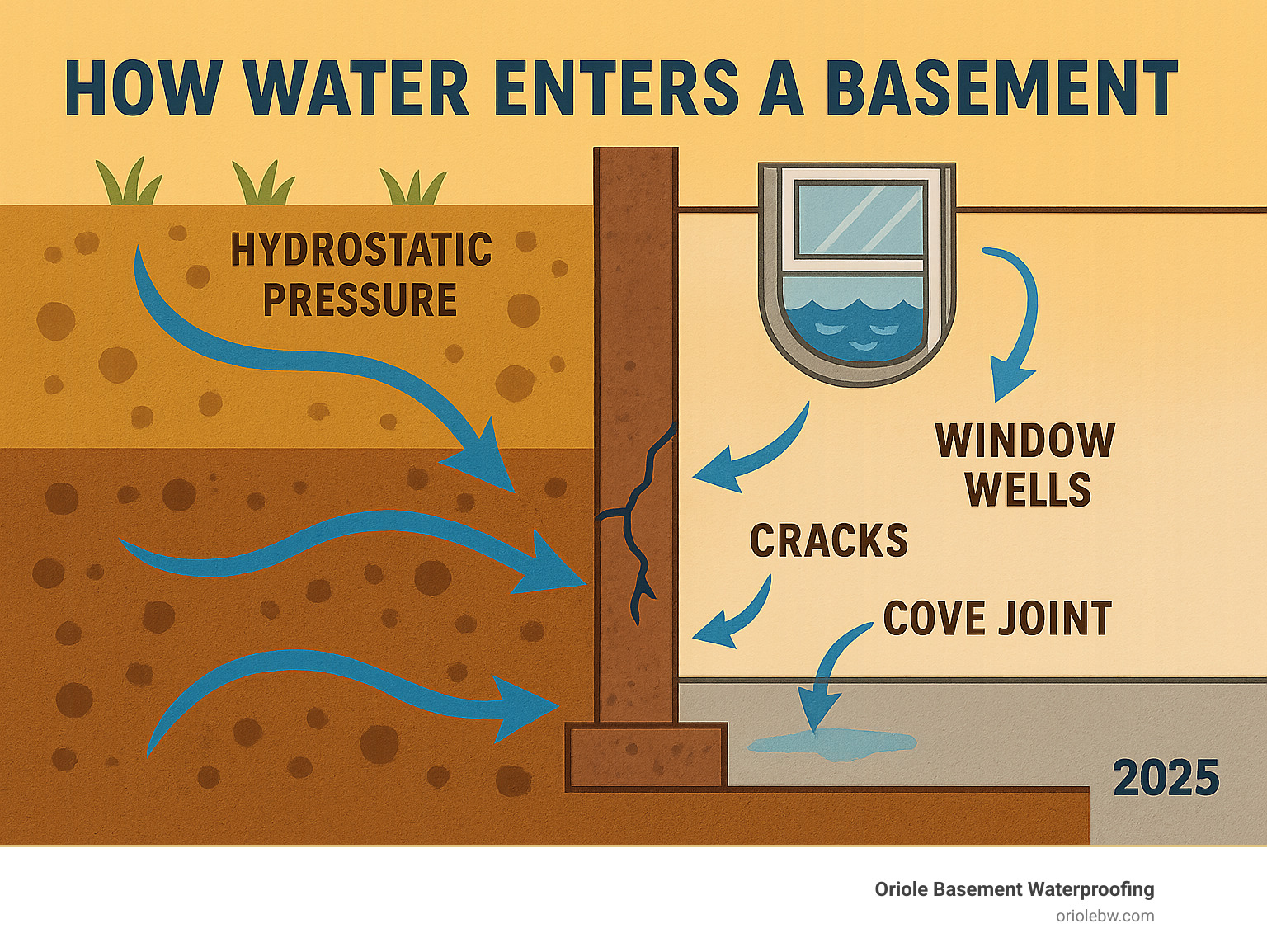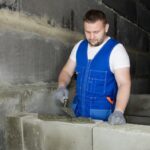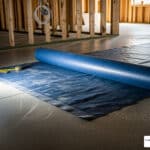That Puddle in the Basement: What It Really Means for Your Home
When you need a basement wall leak fix, you’re looking at more than just a puddle. Here’s what you need to know:
Quick Basement Wall Leak Solutions:
- Identify the source – Check cove joints, wall cracks, and window wells
- Stop active water – Professional crack injection with polyurethane or epoxy
- Control future moisture – Interior drainage systems and sump pumps
- Address the root cause – Exterior grading and proper drainage
- Professional assessment – Determine if it’s a simple leak or foundation issue
That water stain on your basement wall isn’t just an eyesore. It’s your home telling you something important. Maybe you noticed it after a heavy rain, or caught that musty smell downstairs. That damp spot means water is getting through your foundation, and water always finds a way.
Here in the region, our clay soil and seasonal weather create the perfect storm for basement moisture. Saturated soil pushes against foundation walls with incredible force. Add in our older homes with settling foundations, and you have a recipe for leaks.
Don’t just mop it up and hope it goes away. That approach usually leads to bigger problems and bigger repair bills. The good news is most basement wall leaks can be fixed permanently once you understand the cause. Sometimes it’s a simple crack; other times, it’s a sign your foundation or water management needs work.

Don’t Just Mop It Up, Figure It Out
When you find a damp spot or a strange smell in the basement, the first step in any basement wall leak fix is to play detective. Are you seeing water stains creeping up the walls? Have you noticed efflorescence, those powdery white deposits on concrete or masonry? This is a tell-tale sign that water has seeped through your walls and evaporated, leaving mineral salts behind. It’s not mold, but it’s a clear indicator of moisture.
Trust your nose, too. A persistent musty smell often points to damp air, a breeding ground for mildew and mold. Ignoring these signs can lead to health problems and structural damage. In fact, nearly 98% of basements experience water damage at some point. It’s a common problem that demands attention.
Sometimes, the signs are more dramatic, like bowing walls or significant cracks. These aren’t just cosmetic issues; they can indicate serious pressure on your foundation. Understanding these warning signs is crucial. For more on what to look for, explore our guide on Causes and What to Do If You Have a Wet Basement. A wet basement is rarely a one-off event; it signals a deeper issue with how water interacts with your home’s foundation.
How to Spot the Source of Your Basement Wall Leak

Finding where water is getting into your basement can feel like a mystery. The puddle you see might be several feet from where water first entered. Here are the usual suspects:
- The cove joint, where your basement wall meets the floor, is a prime entry point for groundwater under pressure.
- Wall cracks tell a story. Some are hairline fractures from normal settling, while others are wide enough to signal a bigger issue. Their direction, vertical or horizontal, helps us diagnose the problem and urgency of the basement wall leak fix.
- Window wells can become small swimming pools if they don’t drain properly, pushing water right through your basement windows.
- Pipe penetrations for utilities can fail over time, creating a direct highway for water.
- Floor cracks under 1/8-inch are usually cosmetic, but wider ones could signal foundation movement.
Sometimes the problem is internal, like a failing water heater or burst hose. We always check these simple sources first. For a comprehensive look at warning signs, check out our guide on 6 Signs You Need to Get Your Basement Waterproofed.
Is It a Simple Leak or a Foundation Red Flag?
Some leaks are straightforward, but others are your foundation waving a red flag. Hydrostatic pressure is the force of water-saturated soil pushing against your foundation walls. Imagine trying to hold back a swimming pool with concrete; that’s what your foundation deals with during heavy rain.
This region’s clay soil makes this worse through the clay bowl effect. When your home was built, the excavated area was backfilled with looser soil. This disturbed soil forms a bowl that collects water around your foundation like a moat.
These forces cause foundation settlement and cracking. Here’s what we look for: vertical cracks are often from concrete curing, but horizontal cracks or stair-step patterns in block foundations are red flags for serious pressure.
Bowing walls are the ultimate warning sign. If you can see your basement wall curving inward, the soil pressure outside is winning. This isn’t a DIY project; this is “call the professionals immediately” territory. If you’re seeing these signs, you need more than a simple leak repair. Learn more in our guide on Cracked Basement Maryland: Causes and Solutions.
When is a basement wall leak fix a sign of a bigger foundation problem?
Sometimes a simple basement wall leak fix reveals a much more significant issue. Structural issues are the result of constant soil pressure, water table changes, and natural settling over decades. When water repeatedly pushes against your foundation, it can compromise the structural integrity of your entire home.
The soil around local foundations constantly expands and contracts. Saturated clay soil swells and pushes on your walls. When it dries, it shrinks, and your foundation can settle unevenly. This cycle puts tremendous stress on foundation walls, support beams, and floor joists.
That’s why we specialize in comprehensive Foundation Repair solutions that address the root cause. For bowing walls, we install carbon fiber straps to stabilize the foundation. Sometimes the damage is deeper, requiring replacement of damaged sill plates, new support beams, or new floor joists and subfloors that have been exposed to water.
Getting a professional assessment before small problems become big ones is key. We partner with structural engineers on every major foundation repair because guesswork isn’t good enough for your home’s stability. If your basement leak comes with cracking walls or sagging floors, you’re looking at a foundation that needs professional attention.
Your Professional Basement Wall Leak Fix: What to Expect

When you call Oriole for your basement wall leak fix, you’re not getting a quick patch job. You’re getting over 70 years of experience with local homes and a lifetime transferable warranty for real peace of mind.
We don’t just look at the wet spot. We examine your entire foundation, drainage, and humidity levels to see the big picture. Fixing only the symptom means you’ll likely be calling back in a few years.
Our certified technicians use professional-grade equipment and materials unavailable at a hardware store. We take the time to explain what we’re seeing, what’s causing it, and exactly how we plan to fix it permanently.
Sealing Cracks from the Inside
For most foundation wall cracks, sealing from the inside is incredibly effective when done right. We use epoxy injection for structural cracks, creating a bond stronger than the concrete itself. For actively leaking cracks, we use polyurethane injection, which expands to seal against flowing water.
Why not just use hydraulic cement from the store? It’s rigid. When your foundation moves with temperature changes, rigid patches can crack again. Our professional-grade materials are designed to move with your foundation, expanding and contracting without losing their seal. This is why we can back them with a lifetime warranty. For details, check out our Basement Wall Leak Repair page.
Managing Water with an Interior Drainage System
When water pressure is too high for crack sealing alone, we recommend managing the water before it becomes a problem. An interior French drain system intercepts water at the perimeter of your basement floor, giving it a controlled path to follow.
This collected water is directed to a sump pump installation. We always recommend battery backup systems because the storms that cause the most water problems in our area often knock out the power. A battery backup keeps your pump running when you need it most. This system manages water flow before it can cause damage. Learn more in our guide: Why Add a Sump Pump?
Common DIY Mistakes with a basement wall leak fix
We’ve seen many DIY basement wall leak fixes go wrong. The biggest mistake is using caulk or waterproof paint. It’s like putting a raincoat on the inside of your jacket; the water is still there, trapped behind the paint. This causes peeling and deteriorates the concrete, making a bigger mess.
Another common problem is ignoring the exterior cause. Most leaks start outside with poor grading or clogged gutters. Patch the inside without fixing the outside, and water will just find a new way in. The most dangerous mistake is not addressing pressure. A DIY patch is fighting a losing battle against thousands of pounds of water pressure. When it fails, it can create new cracks or even structural damage.
Beyond the Patch: Creating a Permanently Dry Basement

A successful basement wall leak fix isn’t just about stopping the water you see. It’s about creating an environment where water doesn’t stand a chance.
After 70 years in thousands of local basements, we’ve learned that homes that stay dry are the ones where moisture never gets a foothold. This means looking beyond the leak to address how water moves around your property. You can keep patching leaks as they appear, or you can create a system that makes your basement inhospitable to water. The second approach is the permanent solution.
The Ultimate Fix: Basement and Crawl Space Encapsulation
For moisture control that lasts, we recommend encapsulation. This isn’t just another waterproofing technique; it’s a complete change in how your basement or crawl space interacts with the environment.
Encapsulation means wrapping your foundation space in high-performance vapor barriers to create a sealed environment. Think of it as a protective bubble that keeps moisture out and conditioned air in. We use heavy-duty materials designed to last for decades.
The results are transformative. The musty smell disappears, and the dampness is gone. More importantly, you get improved air quality throughout your entire home, as air naturally moves upward from the basement. There are also energy savings, as your HVAC system doesn’t have to work as hard. Most importantly, you’re protecting your home’s structure from moisture, the enemy of wood, metal, and concrete. Learn how it works at Crawl Space Encapsulation 101 and how a Basement Vapor Barrier Protects Against Mold, Rot, and Costly Repairs.
Your First Line of Defense: Exterior Water Management
Before we even touch your basement walls, the real battle happens outside. Exterior water management is where most successful basement wall leak fix projects begin.
Proper grading is the foundation of a dry basement. If your yard slopes toward your house, you’re directing every rainstorm straight to your foundation. We see this constantly in our service area. As houses settle, water that used to flow away starts pooling against the foundation.
Downspout extensions are another game-changer. Short spouts that dump water next to your foundation are working against you. We install extensions and buried drain lines to carry water at least 10 feet away from your home. It’s amazing how often this solves basement leaks. Our approach to Down Spout Extensions & Exterior Drainage has prevented countless floods.
Don’t forget window well maintenance. They can fill up like bathtubs during heavy rains if blocked. Focusing on exterior water management prevents problems rather than just reacting to them. It’s the difference between playing defense and playing offense with water protection.
Frequently Asked Questions about Basement Wall Leaks
We’ve been helping local homeowners for over 70 years, so we hear the same questions pretty regularly. Whether you’re in Baltimore City, Baltimore County, or Harford County, these concerns come up time and again. Let’s tackle them.
What are the white, chalky stains on my basement walls?
Those white, powdery deposits are efflorescence. It’s mineral deposits left behind when water moves through your concrete or masonry walls and then evaporates. Think of the white residue on a flower pot; it’s the same process. Water seeps through your foundation, carrying dissolved minerals. When the water evaporates, it leaves the minerals behind. The good news? It’s not mold. The concerning news? It’s a clear sign of moisture that needs attention before it leads to bigger problems. You can learn more about household moisture and mold from the Environmental Protection Agency (EPA).
Can I just paint over a water stain on my basement wall?
We get this question a lot. Unfortunately, painting over a water stain is a purely cosmetic fix that often makes things worse. You’re trapping moisture behind the paint, which leads to peeling, bubbling, and deterioration. More importantly, paint doesn’t solve the leak; it just hides it while the underlying problem continues. We’ve seen cases where this approach hid ongoing structural damage, turning a manageable repair into a major one.
How much does a professional basement wall repair cost?
This is the question we hear most, and the answer varies by issue. Every basement and every leak is different. A simple crack injection might cost a few hundred dollars, while a comprehensive drainage system is a larger investment. Sump pump installation typically ranges from $600 to $900, or up to $3,500 with a battery backup. Foundation repairs vary significantly based on the damage.
The importance of a free inspection cannot be overstated. We can give you ballpark figures, but until we see your specific situation, any number is a guess. That’s why we offer free, no-obligation inspections to give you accurate information. For a more detailed breakdown, check out our Basement Waterproofing Cost guide. The best way to know what your basement wall leak fix will cost is to have one of our technicians take a look.
Your Dry Basement Starts with a Call to Oriole
When you’re staring at that puddle in your basement, you’re not alone. We’ve been helping local homeowners just like you for over 70 years, and we’ve seen it all, from minor seepage in Baltimore City rowhomes to major foundation issues in Harford County properties.
As a family-owned business, we understand your home is more than a building. It’s where your family gathers and where you’ve invested your hard-earned money. That’s why we don’t just patch problems; we solve them permanently.
Our approach is different. We partner with structural engineers on every major foundation repair, ensuring that when we say your basement wall leak fix will last, we mean it. Our lifetime transferable guarantee isn’t just a piece of paper; it’s our promise that you’ll never have to worry about the same problem twice. If you sell your home, that warranty goes with it, adding real value.
What sets us apart is our white-glove service. From the moment our certified technicians arrive for your free inspection, you’ll know what’s happening. We keep you informed every step of the way, explaining what we find and how we’ll fix it. No surprises, just honest solutions.
Whether you need foundation repair, crawl space encapsulation, or basement waterproofing, we have the expertise to make your basement strong, dry, and healthy. Don’t let that leak turn into a recurring nightmare.
Ready to get your basement back? We’re here to help our neighbors throughout Baltimore City, Baltimore County, and Harford County. Your dry basement starts with one simple call.
Get a free, no-obligation inspection for your Baltimore County home today!






